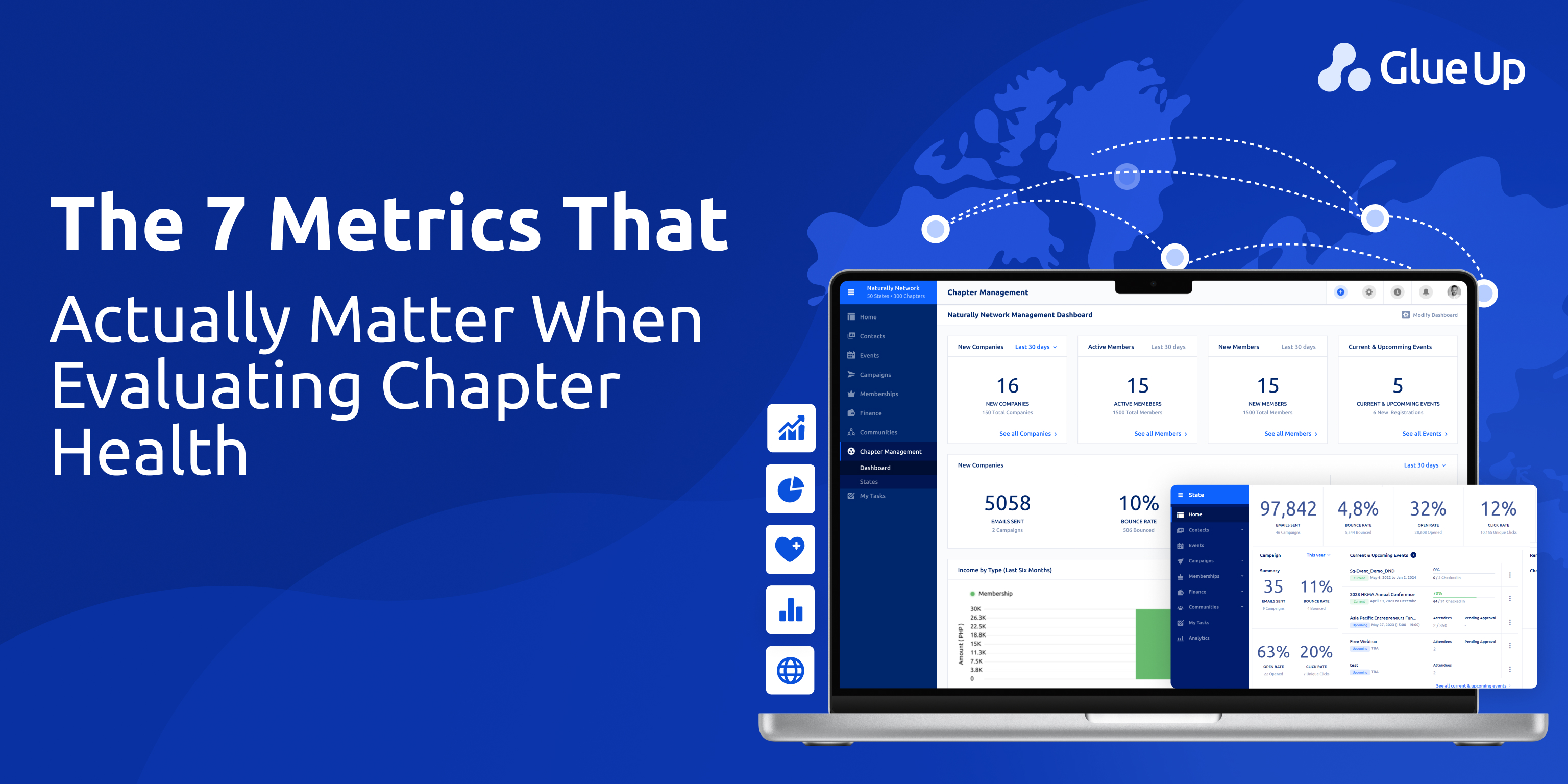
There’s no shortage of dashboards and spreadsheets in the association world. Every chapter leader can point to event headcounts, email open rates, or a well-attended mixer as proof of success. But the reality? Those numbers often tell you more about activity than actual health. A chapter can be buzzing with events, yet membership is quietly shrinking, finances are fragile, and data is a mess. That’s why the real story of sustainable growth is written in a sharper set of indicators, what we’ll call chapter performance metrics.
These aren’t vanity stats. They are the measurable signs of whether a chapter is growing, renewing, engaging, and sustaining itself in a way that creates lasting value. The organizations that monitor them consistently are the ones whose chapters remain stable when trends shift, leaders rotate, or the economy gets rough. The ones that don’t? They’re often the chapters that look lively right up until they start folding.
So let’s cut through the noise. Here are the seven chapter performance metrics that actually matter, and how to use them to build chapters that thrive.
Key Takeaways
First-year renewals are the most predictive signal of long-term chapter health. If they fall below 60 percent, no amount of events or marketing can compensate for the churn.
Engagement needs to be measured as a composite index. True engagement is reflected in event attendance conversion, community activity, and email performance together.
Financial resilience is just as important as member numbers. Chapters with 3–6 months of reserves and sponsorship margins above 75 percent are better positioned to grow sustainably.
Data quality directly determines decision quality. Duplicate records, missing fields, and bounce rates distort every other chapter performance metric and cost millions in lost value.
Leadership capacity and compliance are overlooked but critical. A strong candidate pipeline, trained officers, and on-time reporting are what keep successful chapters running smoothly year after year.
Why Chapter Performance Metrics Beat Activity Tracking
Chapter boards often confuse movement with momentum. More events, more emails, more posts in the community platform. But activity isn’t the same thing as health. A chapter could host ten events in a year, but if first-year renewal rates are tanking or financial reserves are thin, those events aren’t a sign of strength, they’re a distraction from fragility.
Research backs this up. The Marketing General Incorporated (MGI) benchmarking report finds that while overall renewal rates hover around the low-80s, first-year renewals are often closer to 60 percent. The difference matters. Chapters that ignore that early leak lose future revenue streams and long-term advocates. Similarly, Higher Logic’s community data shows that while most associations see about 15 percent of members active over a 120-day period, only 14 percent of those active members contribute. Without engagement depth, community participation becomes a hollow vanity metric.
And then there’s the hidden cost of poor data. Gartner estimates organizations lose nearly $13 million annually to data issues, while IBM reports that 68 percent of enterprise data is never analyzed. For chapter-based organizations, bad data at the local level multiplies quickly. HQ leaders can’t make sound decisions if half the chapter rosters are riddled with duplicates, missing emails, or unreported churn.
This is why we need to move past surface-level reporting and focus on the metrics that actually explain whether a chapter is healthy.
Chapter Performance Metrics That Actually Matter
Net Membership Growth Rate
This is the first lens into chapter health because it answers the simplest question: are more people joining than leaving? The formula is straightforward:

How many new members were acquired? How many reinstated? How many transferred in or out? How many failed to renew?
Healthy chapters show steady positive growth, often modest (3 to 5 percent per year) but reliable. Growth without retention is churn disguised as momentum. Retention without growth is stagnation. The right balance is the real signal.
Glue Up helps leaders see this at a glance, surfacing both net change and cohort breakdowns in a dashboard so HQ and chapters can align on what’s really happening.
Renewal Rates Overall and First Year
If there’s one metric that separates mature chapters from vulnerable ones, it’s this. Renewal rates tell you whether members are finding sustained value. But the real insight comes when you split them into two groups: overall renewals and first-year renewals.
Why? Because first-year behavior is predictive. If a chapter has a 63 percent first-year renewal rate but an 85 percent overall rate, it means the value story isn’t landing fast enough. The first year is when most members decide if joining was worth it.
MGI reports that first-year renewals typically run 20 points lower than overall rates. That gap is your early warning system. If it widens, no number of events or newsletters will save the long-term pipeline.
Glue Up automates renewal nudges, tracks both segments, and lets leaders design interventions specifically for first-year members, whether that’s mentorship, welcome calls, or tailored content.
Engagement Index Across Events, Community, and Email
Engagement can’t be boiled down to one number, but it can be synthesized into an index that reflects whether members are active and connected. Think of it as a composite score across three channels:
Event conversion: Are people who register actually showing up? ON24’s benchmarks show median conversion from registration to attendance at around 57 percent. That’s a baseline. Anything higher signals strong pull; anything lower signals fatigue.
Community activity: Higher Logic reports that about 15 percent of members engage in a 120-day window. Among them, only 14 percent contribute content. That means a chapter with 1,000 members might only see 21 active contributors. Chapters that boost this ratio by encouraging mentorship, discussions, or volunteering often see broader ripple effects.
Email engagement: Daily or weekly digest opens average 43 to 59 percent in associations. Anything under 30 percent should be a flag.
By weighting these factors, say 40 percent events, 40 percent community, 20 percent email; you can build a score that lets you compare chapters month to month. Glue Up makes this practical by consolidating event attendance, community logins, and email performance in one analytics hub.
Financial Runway and Revenue Mix
A chapter that can’t pay its bills isn’t healthy, no matter how strong its programming looks. Financial health comes down to three signals:
Operating surplus or margin: Are revenues consistently greater than expenses?
Reserves: Nonprofits are often advised to maintain 3 to 6 months of operating expenses in reserves. Less than that leaves a chapter vulnerable to sudden shocks.
Sponsorship margins: A practical rule is that sponsorship activation costs should not exceed 25 percent of revenue. Any higher, and the program risks becoming unprofitable.
This is about resilience. Chapters with solid reserves and healthy margins weather downturns and invest in innovation. Chapters without them are forced into survival mode.
Glue Up’s finance integrations (QuickBooks, Xero, Sage Intacct) allow HQ to pull consistent data across chapters, giving national leaders visibility into where reserves are healthy and where interventions are needed.
Data Health Score
Bad data is the silent killer of chapter health. Inaccurate rosters lead to miscounted members, bounced emails, and wasted outreach. Poor data distorts every other metric.
A simple way to score data health is to measure:
Required field completeness (are contact details filled in?)
Duplicate rate
Deliverability (percentage of hard and soft bounces)
Record freshness (when was the last update?)
Gartner estimates poor data costs organizations $12.9 million annually. IBM finds 68 percent of data goes unanalyzed. For multi-chapter orgs, the stakes are even higher: if chapter data doesn’t roll up cleanly, HQ is flying blind.
Glue Up’s CRM tools help chapters audit duplicates, enforce required fields, and track bounce rates. Adding a monthly “data score” to chapter dashboards signals that data is a health metric.
Member Satisfaction and Program Quality
Not all value is captured in numbers, but member satisfaction is too important to leave anecdotal. That’s where tools like Net Promoter Score (NPS) and CSAT surveys come in.
NPS is simple, portable, and comparable: “On a scale of 0 to 10, how likely are you to recommend this organization?” The percentage of promoters minus detractors gives you a score. Across industries, mid-40s is average. For chapters, it’s an easy way to track loyalty over time.
Satisfaction doesn’t live in a vacuum. Research shows that associations that adopt digital tools earlier report higher satisfaction and loyalty. That suggests members interpret digital maturity as a signal of professionalism and reliability.
Glue Up integrates surveys directly after events or as quarterly pulses, tying feedback to actual engagement data. That’s how you move satisfaction from anecdotes to a measurable chapter performance metric.
Leadership Capacity and Compliance
Even the healthiest metrics collapse if there’s no leadership pipeline. Leadership capacity is about more than having warm bodies in officer roles. It’s about having enough candidates to avoid vacancies, ensuring leaders are trained, and confirming that required reports are filed on time.
ASAE guidance suggests tracking volunteer KPIs alongside operational compliance. Chapters with consistent leadership and timely reporting are more likely to deliver reliable programming and member care. Chapters with vacancies and compliance issues are often in crisis mode.
Simple indicators: vacancy rate, candidate-to-seat ratio, on-time reporting; tell you whether leadership capacity is strong or strained. Glue Up workflows make compliance and approvals easier to manage, reducing the friction that burns out volunteer leaders.
Building a Chapter Scorecard That Leaders Actually Use
Metrics are useless if they overwhelm the people meant to act on them. That’s why the most effective organizations package these seven chapter performance metrics into a single one-page scorecard.
Keep it simple:
Seven dials, each with red/yellow/green thresholds
Quarterly reviews that last no longer than 30 minutes
No more than three follow-up actions
This isn’t about overloading leaders with data, it’s about giving them clarity. When a chapter president sees that their first-year renewals are red, they know exactly where to focus. When HQ sees a chapter with less than one month of reserves, it’s clear where financial coaching is needed.
Glue Up can replicate this scorecard directly in its dashboards, creating a “single pane of glass” for HQ and chapters alike.
Common Traps When Using Chapter Performance Metrics
Vanity counts: Tracking number of events instead of conversion rates.
Ignoring first-year renewals: Missing the most predictive signal of long-term growth.
Overreliance on dues: Neglecting sponsorship margins or reserve health.
No data audits: Letting duplicates and outdated contacts quietly erode every metric.
Leadership blind spots: Assuming chapters with current officers are healthy, even when vacancies loom.
Chapters fall into these traps when they mistake activity for health. The antidote is focus: seven metrics, one scorecard, quarterly action.
From Metrics to Moves: Five Plays to Run This Quarter
Metrics without action are just math. Here are five moves any organization can pilot in the next 90 days:
First-year renewal sprint: Identify members up for first renewal, and launch a mentorship or personal outreach campaign.
Data clean-up day: Give each chapter a duplicate report and an incentive to clean records.
Reserve policy workshop: Train treasurers on reserve targets and how to report consistently.
Community mentor program: Pair new members with experienced ones to boost community contributions.
Leadership pipeline review: Audit vacancies and candidate pools; start grooming successors early.
These actions don’t require massive budgets, just discipline. And they directly improve the chapter performance metrics that matter.
Conclusion
Healthy chapters aren’t built on charisma, or even activity. They’re built on consistent attention to the seven chapter performance metrics that predict sustainability: growth, renewals, engagement, financial health, data quality, member satisfaction, and leadership capacity.
The organizations that focus here can spot risks early, act decisively, and keep chapters strong for decades. The ones that don’t? They may not even notice decline until it’s too late.
The choice is simple: measure what matters, or chase vanity metrics until the floor falls out.
Want a one-page scorecard you can roll out across chapters next quarter? Book a demo today and see how Glue Up turns these seven metrics into a single dashboard.



